There’s something magical about the moment a child recognizes their first letter. That spark of understanding, followed by excitement as they connect sounds to symbols, marks the beginning of a lifelong literacy journey. Alphabet worksheets for kids provide a structured yet playful approach to mastering these fundamental building blocks of language. As parents and educators, we know that strong alphabet recognition leads to reading readiness, but the path to literacy shouldn’t feel like a chore – it should be an adventure filled with discovery.
This comprehensive guide explores how thoughtfully designed alphabet worksheets can transform learning letters from a routine task into an engaging experience that children eagerly anticipate. Whether you’re teaching a classroom of preschoolers or working one-on-one with your child at the kitchen table, these activities offer versatile approaches to suit different learning styles, attention spans, and developmental stages.
From tracing exercises that build fine motor skills to sensory play that makes abstract concepts concrete, we’ll cover evidence-based strategies that make alphabet learning stick. Let’s unlock the potential of early literacy together, setting our little ones on a path to becoming confident readers and communicators through play-based learning that respects both their capabilities and their childhood.
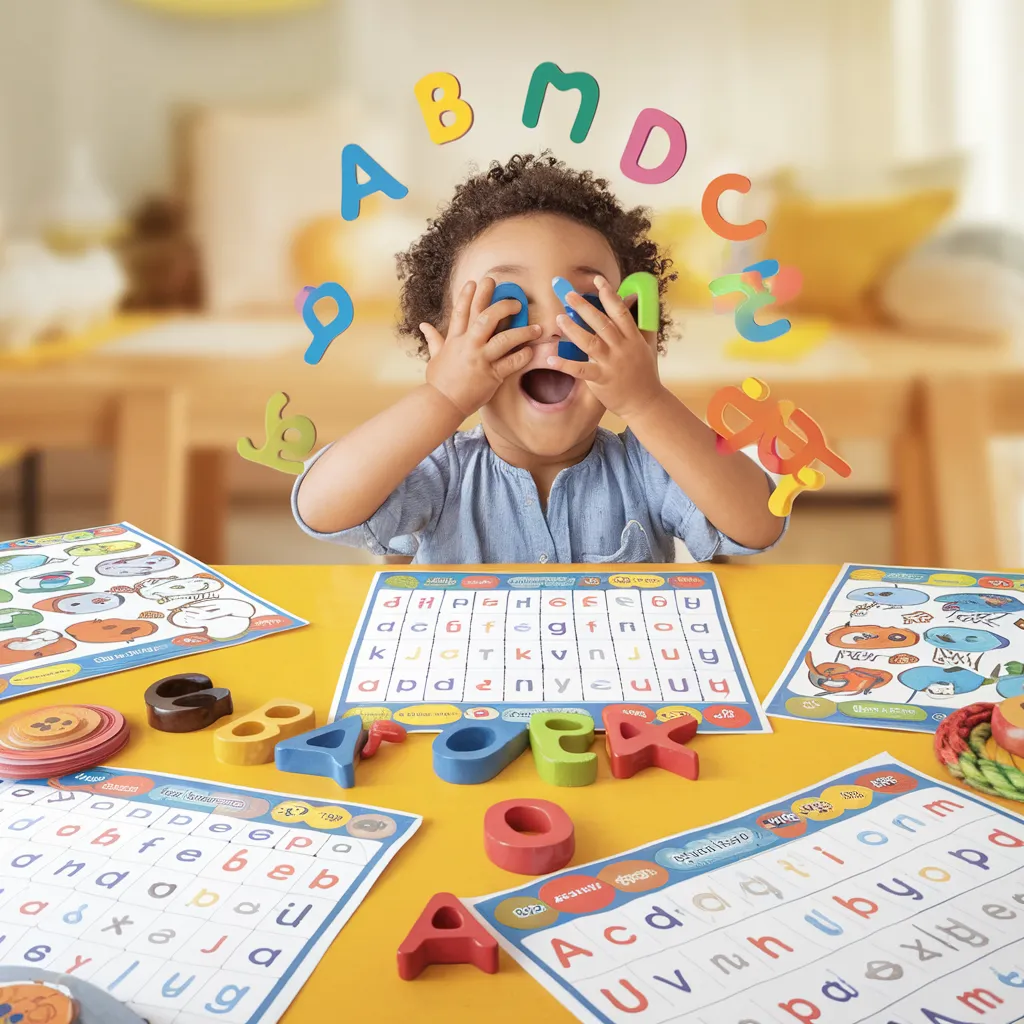
The Foundation of Literacy: Understanding Alphabet Basics
Before diving into worksheets and activities, it’s important to understand what children need to master when learning the alphabet. This foundation helps create more meaningful learning experiences.
What Children Need to Know About Letters
Alphabet learning involves several interconnected skills:
- Letter recognition – identifying the 26 letters in both uppercase and lowercase forms
- Letter-sound correspondence – connecting each letter to its phonetic sound(s)
- Letter formation – understanding how to write each letter correctly
- Alphabetical order – learning the conventional sequence of letters
- Conceptual understanding – grasping that letters combine to form words that carry meaning
Children don’t need to master all these aspects simultaneously. In fact, a developmentally appropriate approach introduces these concepts gradually, building connections through repeated exposure and varied experiences.
Best Age to Start Reading Preparation
While every child develops at their own pace, most educational experts suggest that formal alphabet instruction can begin around age 3-4, when children show interest in print and have developed sufficient visual discrimination skills. However, informal exposure to letters through books, environmental print, and conversation can begin from infancy.
Signs your child may be ready for more structured alphabet learning include:
- Showing interest in books and printed materials
- Recognizing some environmental print (like familiar logos)
- Asking questions about letters or words they see
- Attempting to « write » by scribbling or making letter-like shapes
- Demonstrating sustained attention during short reading sessions
Remember that forcing alphabet learning before a child shows readiness can create unnecessary frustration. The goal is to nurture curiosity and positive associations with literacy.
Learning Through Play: Making Alphabet Worksheets Engaging
The most effective learning happens when children are actively engaged and enjoying themselves. This section explores how to incorporate playfulness into worksheet activities.
Why Playful Learning Works Better
Research consistently shows that play-based approaches lead to better outcomes for young learners. When children learn through play:
- Information transfers more readily from short-term to long-term memory
- Stress hormones decrease, creating optimal brain states for learning
- Intrinsic motivation increases, reducing the need for external rewards
- Creative thinking flourishes alongside academic skills
- Social-emotional development occurs alongside cognitive growth
Effective alphabet worksheets incorporate playful elements while maintaining educational value, striking a balance between structure and freedom.
Transforming Traditional Worksheets into Games
Even basic alphabet worksheets can become engaging with simple modifications:
- Add movement – Have children hop to each letter on a worksheet spread on the floor
- Incorporate challenges – « Can you find all the letters in your name on this page? »
- Use manipulatives – Place stickers, stamps, or small toys on correct answers
- Set timers – « Let’s see how many ‘A’ words we can think of before the sand runs out! »
- Create stories – Invent narratives about the characters or objects on the worksheet
These small adjustments transform passive worksheet completion into active learning experiences that children eagerly anticipate.
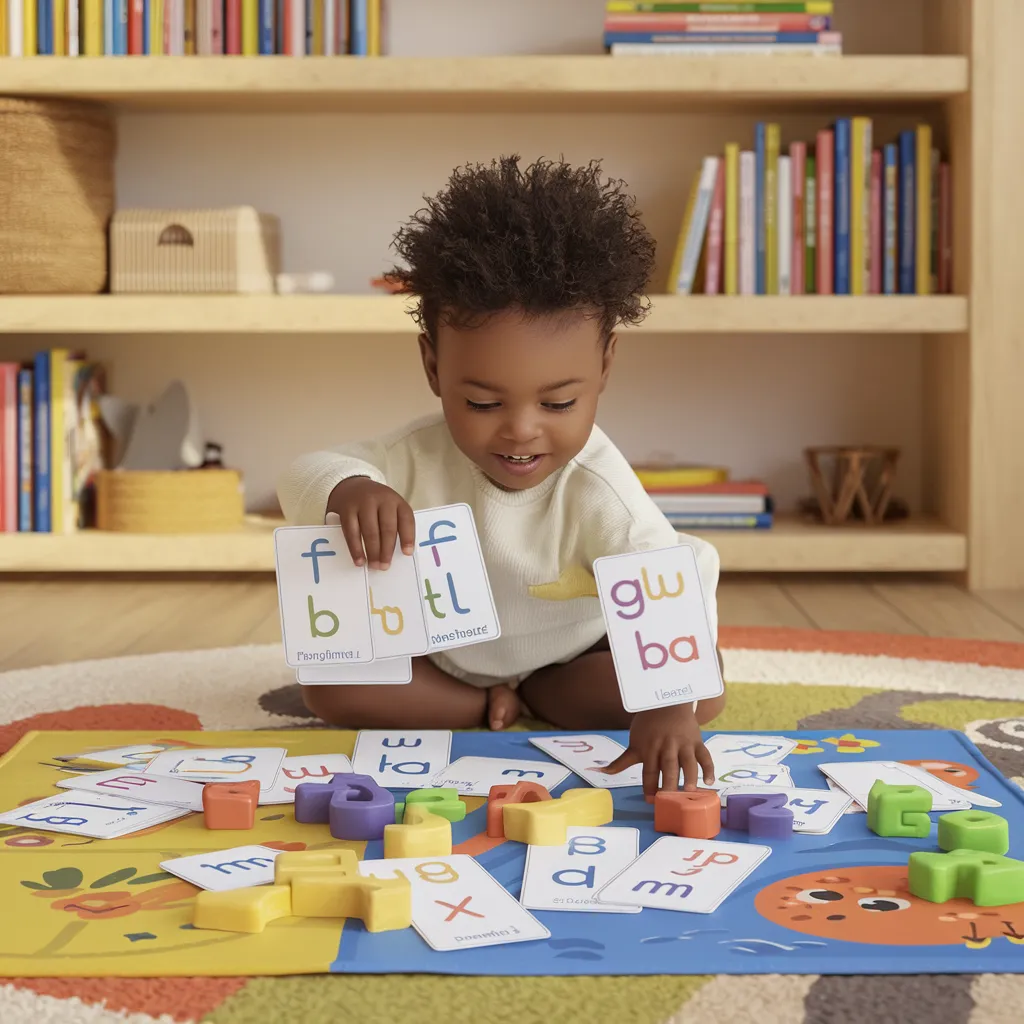
Types of Alphabet Worksheets for Different Learning Stages
As children progress in their understanding of letters, different types of worksheets become appropriate. This section outlines a developmental sequence of worksheet activities.
Early Exposure: Letter Recognition Activities
For beginners, focus on broad recognition before details:
- Letter hunt worksheets – Finding specific letters among distractors
- Environmental alphabet searches – Matching letters to objects that begin with them
- Letter matching pages – Connecting uppercase to lowercase or letters to pictures
- Alphabet puzzles – Completing simple letter-based puzzles with visual supports
- Color-coding activities – Using colors to distinguish between different letters
These activities familiarize children with letter shapes and names without pressure to write or produce sounds independently.
Developing Skills: Phonics and Writing Integration
As recognition strengthens, introduce activities that connect letters to sounds and writing:
- Beginning sound worksheets – Matching letters to pictures that start with their sounds
- Letter tracing pages – Following directional arrows to learn proper formation
- Word family activities – Identifying patterns in words that share endings (cat, hat, bat)
- CVC word building – Creating simple consonant-vowel-consonant words
- Letter stroke practice – Focusing on the component movements of letter formation
These worksheets build on recognition skills while introducing new dimensions of alphabet knowledge.
Advanced Applications: Reading Readiness Worksheets
For children nearing reading readiness, worksheets can bridge to comprehension:
- Simple sentence completion – Using letter knowledge to finish short sentences
- Word-picture matching – Connecting written words to corresponding images
- Rhyming activities – Identifying words that share end sounds
- Letter pattern recognition – Finding recurring letter combinations
- Sight word introduction – Beginning to recognize common non-phonetic words
These advanced worksheets prepare children for the transition from letter recognition to actual reading.
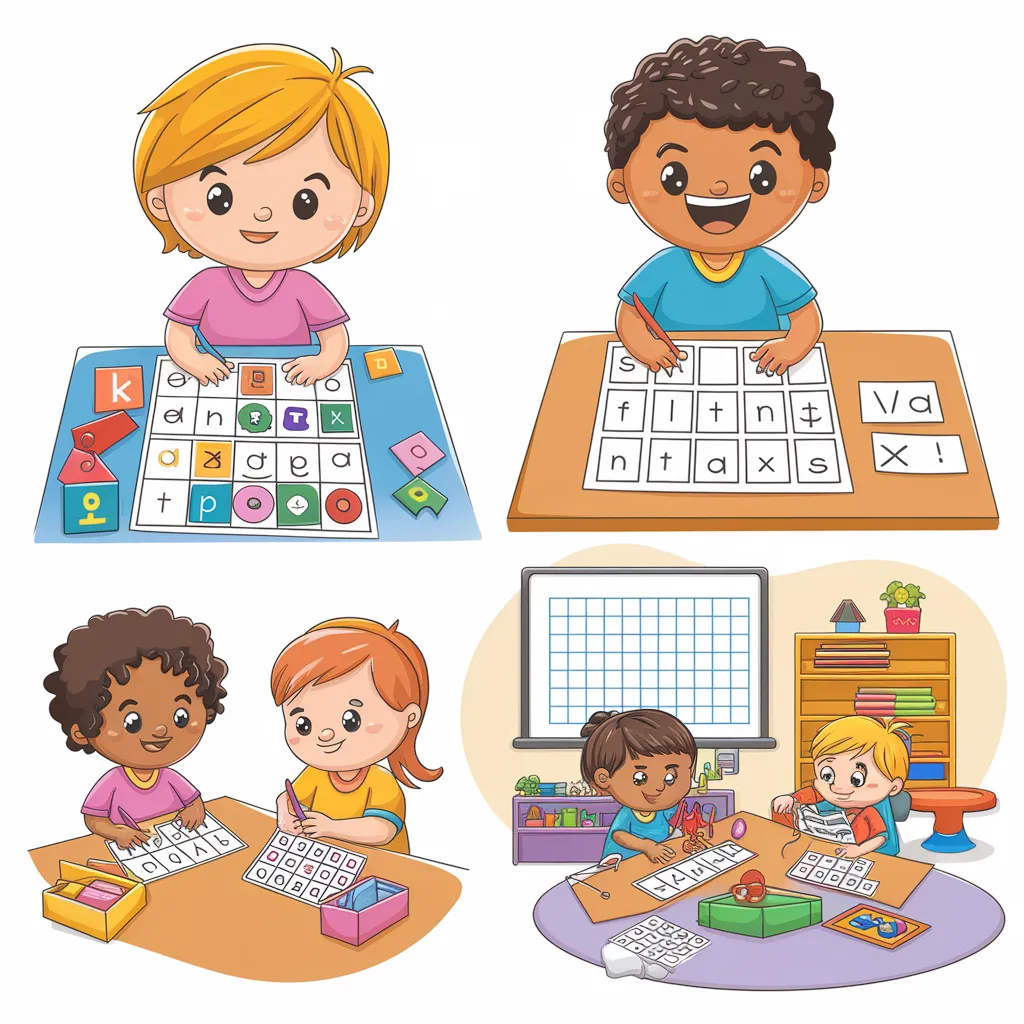
Montessori Methods for Letters: Bringing Sensory Learning Home
Montessori education emphasizes sensory experiences and self-directed learning. These principles can enhance alphabet worksheets significantly.
Tactile Learning Approaches
Incorporating touch makes letter learning more concrete:
- Sandpaper letters – Tracing textured letters while saying their sounds
- Salt/sand tracing – Writing letters in sensory materials
- Playdough letter formation – Creating letters from malleable materials
- Texture sorting – Grouping letters by shared features (straight lines vs. curves)
- 3D letter exploration – Manipulating wooden or plastic letters to understand their shapes
These tactile approaches create multiple neural pathways for learning, strengthening memory and understanding.
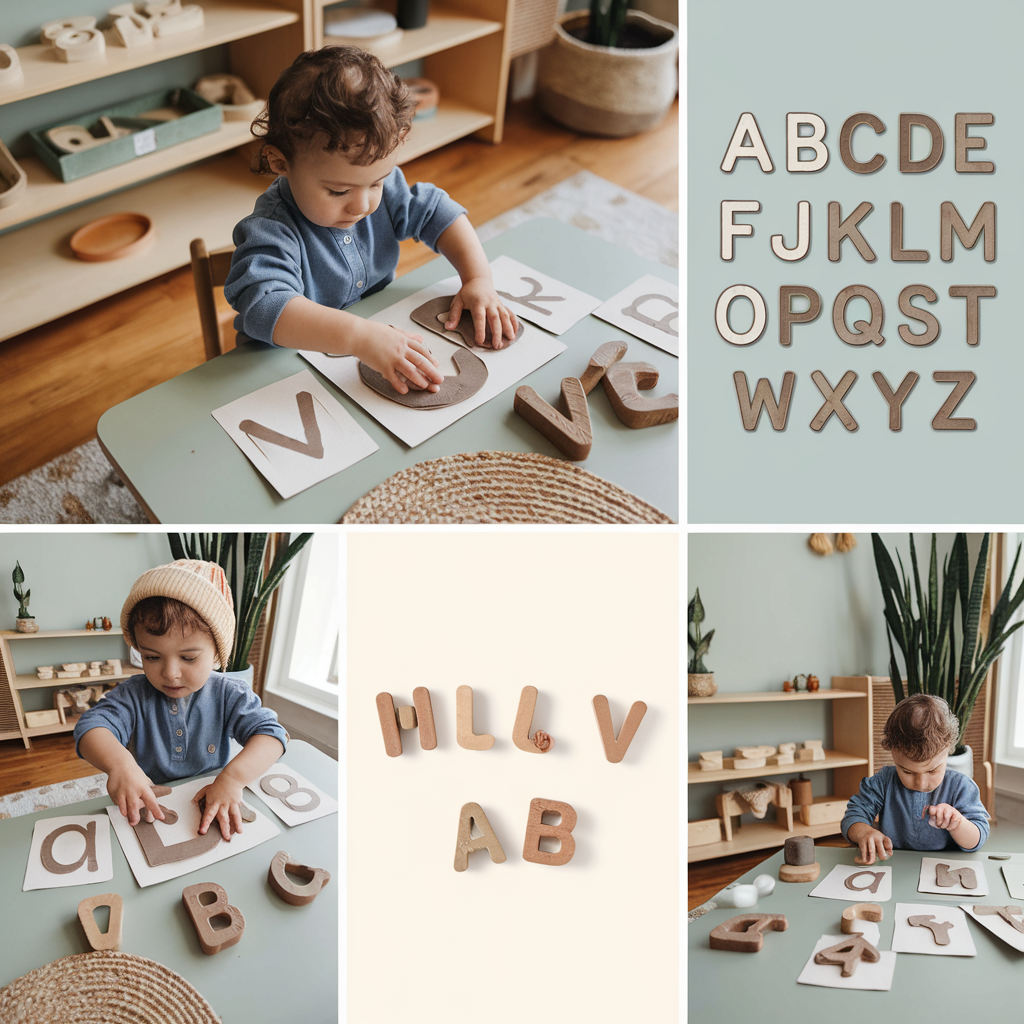
Practical Life Connections
Montessori education connects abstract concepts to practical applications:
- Kitchen alphabet activities – Sorting foods by initial sounds
- Household letter hunts – Finding objects that begin with target letters
- Natural materials alphabet – Creating letters using sticks, stones, or leaves
- Practical writing opportunities – Making shopping lists or simple notes
- Object box sorting – Categorizing small objects by their initial sounds
These connections help children understand the purpose of letters in everyday life, increasing motivation to master them.
Teaching Toddlers the Alphabet: Early Introduction Strategies
While formal instruction may wait until preschool age, toddlers can build pre-literacy skills through appropriate exposure.
Building Pre-Literacy Skills
Before letter recognition comes more fundamental abilities:
- Visual discrimination activities – Noticing differences between similar shapes
- Listening games – Developing phonological awareness through sound play
- Fine motor worksheets – Strengthening hand muscles needed for writing
- Book handling practice – Learning how books work (front/back, page turning)
- Language enrichment – Expanding vocabulary through conversation and reading
These foundational skills create the neurological infrastructure needed for later alphabet learning.
Making Letters Relevant to Toddlers
Young children learn best when content connects to their interests:
- Personalized alphabet books – Creating simple books featuring familiar people and objects
- Name recognition activities – Starting with the letters in their own name
- Theme-based letter exploration – Connecting letters to favorite topics (animals, vehicles)
- Routine-based exposure – Incorporating letter awareness into daily activities
- Sensory-rich introduction – Using song, movement, and touch to introduce letter concepts
These approaches leverage toddlers’ natural curiosity about themselves and their world to build early letter awareness.
Alphabet Learning Games: Beyond Traditional Worksheets
While worksheets provide structure, complementary games reinforce learning through different modalities.
Active Games for Kinesthetic Learners
Movement-based activities energize alphabet learning:
- Alphabet hopscotch – Jumping to letters called out
- Letter freeze dance – Freezing in letter shapes when music stops
- Alphabet obstacle courses – Completing tasks associated with different letters
- Bean bag toss – Throwing markers onto target letters
- Body spelling – Forming letters with arms, legs, or in groups
These games are especially valuable for children who struggle with seated activities or need physical engagement to maintain focus.
Digital Complements to Paper Worksheets
Thoughtfully selected technology can enhance traditional materials:
- Interactive alphabet apps – Providing feedback and progressive challenges
- Digital letter tracing – Offering guidance and immediate correction
- Audio-supported activities – Reinforcing correct letter sounds
- Virtual letter manipulation – Allowing exploration of letter formation
- Adaptive practice – Adjusting to individual learning needs
Technology works best when it complements rather than replaces hands-on learning, offering additional practice in engaging formats.
Customizing Worksheets for Different Learning Styles
Every child learns differently, and the most effective instruction acknowledges these differences.
Visual, Auditory, and Kinesthetic Adaptations
Simple modifications can target different learning preferences:
- For visual learners – Add color coding, pictures, and visual patterns
- For auditory learners – Incorporate songs, rhymes, and verbal instructions
- For kinesthetic learners – Include cutting, folding, and manipulating elements
- For logical learners – Create patterns, sequences, and classification activities
- For interpersonal learners – Design worksheets that encourage collaboration
These adaptations help all children access content in ways that make sense to them.
Supporting Children with Learning Differences
Inclusive worksheet design considers diverse needs:
- Simplified visual field – Reducing distractions for focusing challenges
- Step-by-step progressions – Breaking tasks into manageable parts
- Multi-sensory reinforcement – Providing multiple ways to engage with each letter
- Success-oriented design – Ensuring achievable challenges that build confidence
- Adaptive difficulty – Offering options for different ability levels
These considerations make alphabet learning accessible to all learners, including those with special educational needs.
Creating a Print-Rich Environment at Home
Worksheets exist within a broader literacy context. This section explores how to create supportive learning environments.
Everyday Literacy Opportunities
Letters appear everywhere in daily life:
- Environmental print awareness – Noticing letters on signs, packages, and labels
- Writing materials access – Maintaining a simple writing station with alphabet references
- Purposeful writing activities – Creating shopping lists, cards, and notes together
- Letter-focused conversations – Discussing letters spotted during outings
- Alphabet enhancement of play spaces – Incorporating letter materials into play areas
These environmental supports reinforce worksheet learning through natural, contextual exposure.
Building a Home Library That Supports Alphabet Learning
Books play a critical role in literacy development:
- Alphabet-specific books – Featuring letters in engaging ways
- Predictable text selections – Building confidence through repetition
- Phonics-based early readers – Supporting sound-letter connections
- Interest-driven choices – Connecting literacy to personal passions
- Interactive book formats – Encouraging active engagement with text
Regular reading sessions complement worksheet activities by showing letters in meaningful contexts.
Tracking Progress and Celebrating Milestones
Assessment shouldn’t feel like testing for young children, but tracking progress helps guide instruction.
Observable Indicators of Alphabet Mastery
Look for these signs of growing competence:
- Spontaneous letter identification – Pointing out letters in the environment
- Consistent sound production – Accurately connecting letters to sounds
- Independent writing attempts – Using letters intentionally in drawing and writing
- Alphabetic principle understanding – Grasping that letters represent speech sounds
- Applied knowledge – Using letters functionally in daily activities
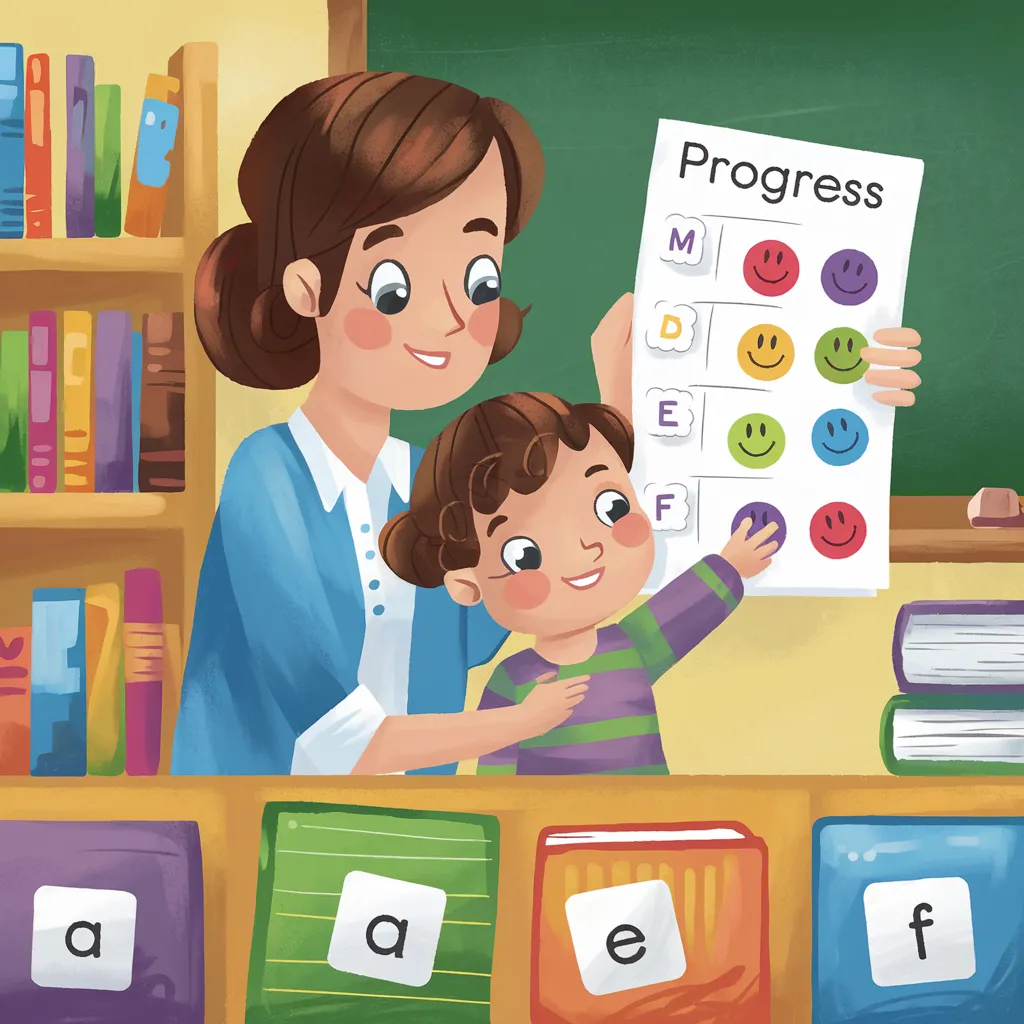
These natural demonstrations of learning often provide more authentic assessment than formal testing.
Meaningful Ways to Acknowledge Learning
Celebration reinforces motivation:
- Alphabet progress charts – Visually tracking letters mastered
- Special privileges – Earning roles like « letter helper » or « word detective »
- Documentation – Creating portfolios of worksheet accomplishments
- Sharing opportunities – Demonstrating new skills to family members
- Connection to interests – Relating alphabet achievements to favorite activities
Effective celebration focuses on effort and progress rather than perfection, building a growth mindset around literacy.
Conclusion: Building Lifelong Literacy Through Early Alphabet Experiences
The journey of alphabet learning lays groundwork far beyond letter recognition – it shapes a child’s relationship with literacy itself. When we provide thoughtfully designed alphabet worksheets within a context of playful learning, we’re not just teaching letters; we’re nurturing curious minds that view reading and writing as joyful tools for exploration and expression.
The approaches outlined in this guide emphasize that alphabet learning shouldn’t be rushed or reduced to rote memorization. Instead, it should unfold naturally through varied experiences that respect children’s developmental stages and individual learning styles. By integrating sensory play, movement, personal connections, and practical applications, worksheet activities become meaningful stepping stones toward literacy rather than isolated exercises.
Remember that consistency matters more than intensity. Brief, regular engagement with alphabet concepts through diverse activities builds stronger neural pathways than occasional intensive sessions. Celebrate small victories, model your own enjoyment of reading and writing, and trust the process – even when progress seems uneven.
As you implement these strategies at home or in educational settings, keep the ultimate goal in mind: nurturing children who approach text with confidence and curiosity. The foundation you’re building through these early alphabet experiences will support not just academic success but a lifelong relationship with the written word. By making this foundation both solid and joyful, you’re giving children one of the greatest gifts possible – the tools to become independent readers, thinkers, and communicators in an increasingly text-rich world.
7 Smart Ways to Teach the Alphabet to Children
FAQ: Common Questions About Alphabet Learning
At what age should children know all their letters?
While developmental timelines vary significantly, most children recognize most letters by around age 4-5, with full mastery of recognition, sounds, and formation typically occurring between ages 5-6. However, this isn’t a strict deadline – some children learn letters earlier or later based on exposure, interest, and individual development. Rather than focusing on age-based expectations, look for steady progress and continued engagement with alphabet activities. If a child shows persistent difficulty with letter recognition beyond age 6 despite consistent exposure, consulting with an educational specialist may be helpful.
Should I teach uppercase or lowercase letters first?
Research suggests that starting with uppercase letters may be advantageous for several reasons: they’re visually simpler, more distinct from each other, and appear frequently in environmental print like signs and product names. However, many educators recommend introducing both forms gradually, with slightly more emphasis on uppercase initially. A balanced approach might involve teaching uppercase forms first while occasionally pointing out lowercase equivalents, then transitioning to more formal lowercase instruction as uppercase recognition becomes secure. Consider your child’s specific interests too – some children show particular curiosity about one form or the other.
How can I help my child who mixes up similar letters like b/d or p/q?
Letter reversals are completely normal until around age 7 and don’t necessarily indicate learning disorders. To help children with frequently confused letters:
- Use tactile approaches like tracing letters in sand or forming them with clay
- Create memorable associations (b has a « belly » while d has a « diaper »)
- Practice discrimination activities that directly compare similar letters
- Use kinesthetic memory aids (like forming the letters « b » and « d » with thumbs and fingers)
- Provide consistent feedback without expressing frustration
- Give extra practice with these letters in meaningful contexts
With additional exposure and appropriate support, most letter confusion resolves naturally over time.
How many letters should we practice in one sitting?
Short, frequent practice sessions are more effective than lengthy ones. For younger children (ages 3-4), focus on just 1-3 letters per session for 5-10 minutes. For older preschoolers and kindergarteners (ages 4-6), you might work with 3-5 letters for 10-15 minutes. Pay attention to your child’s engagement level – if they’re showing signs of fatigue or frustration, it’s better to end on a positive note and return to practice later. Create natural rhythms by establishing brief daily routines like identifying a « letter of the day » or incorporating letter practice into transition times.
What if my child shows no interest in alphabet worksheets?
If traditional worksheets don’t appeal to your child, consider these alternatives:
- Incorporate letters into their existing interests (finding letters in train names for train enthusiasts)
- Use more active approaches like letter hunts, movement games, or outdoor alphabet activities
- Create personalized materials featuring favorite characters or topics
- Try different formats like puzzles, stamps, magnets, or digital activities
- Take a break from formal instruction and focus on reading enjoyable books together
- Observe what types of learning activities do engage them and adapt alphabet learning accordingly
Remember that children learn through many different modalities – worksheets are just one tool among many for building alphabet knowledge.

Ping : 2 Whale Hello There – Free Ocean Coloring Page for Kids - smartkidsprintable
Ping : 15 Proven Ways to Teach the Alphabet Effectively (Fun & Easy Methods) - smartkidsprintable
Ping : 25 Exciting Alphabet Activities Preschool Children Will Love - smartkidsprintable